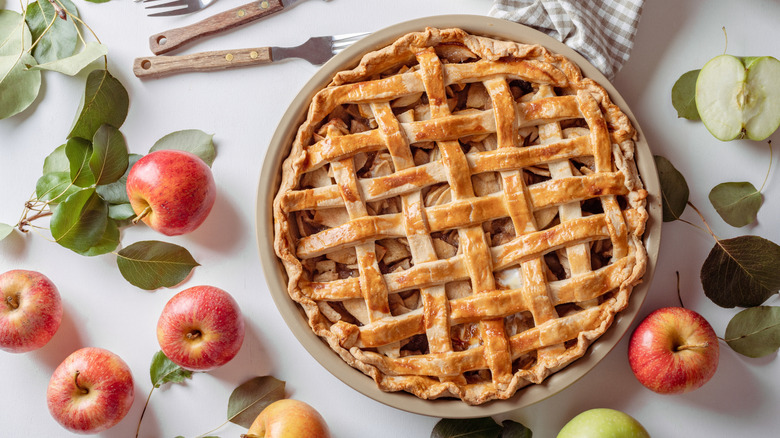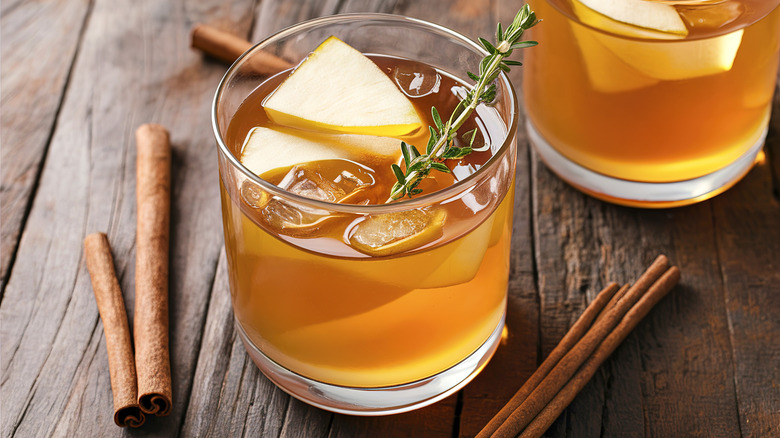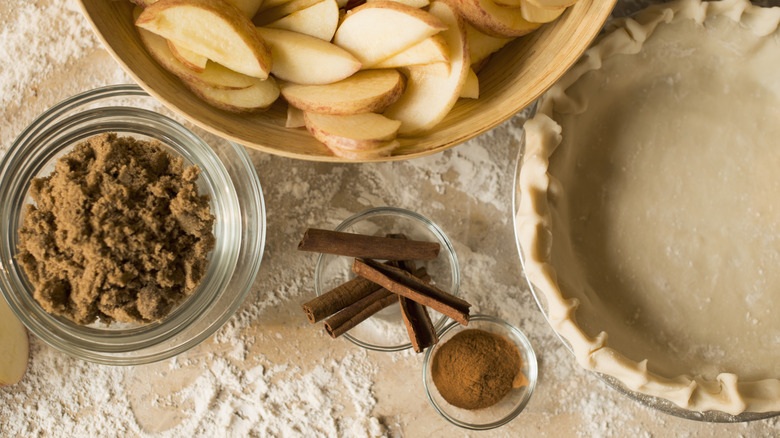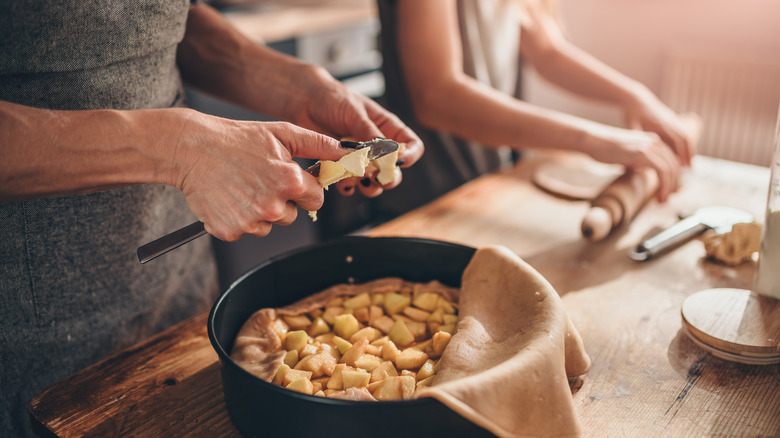How Apple Pie Became An American Icon
We may receive a commission on purchases made from links.
Here's the thing about apple pie being the dessert food icon of America. Given that the apples, the spices, and the recipes for the pie came from other lands around the globe, you could make the argument that apple pie is supremely American. That is to say, America is known as the great melting pot, due to the disparate peoples who settled this land, most of whom — with the exception of the Native Americans — also came from other lands. America is a mix of cultures and influences, so why shouldn't the country's national dessert be a mix of culinary influences, too? Still, it took quite a bit of time for apple pie to become America's favorite dessert. Suffice it to say that it all started when American settlers decided they wanted to create some culinary independence from Britain and to forge their own foodie identity.
However, to arrive at this new culinary identity, settlers required a detour and more than a bit of motivation and inspiration. Although the United States now grows some 2,500 apple varieties, 100 of which are available commercially, apples aren't native to this country. They were first discovered in Asia 750,000 years ago before eventually landing on Europe's shores. It was thanks to the early settlers that apple seeds and tree cuttings arrived on American soil.
From cider to seeder
Settlers didn't have apple pies in mind when they packed up their personal apple tree cuttings and seeds to bring with them to the New World. Instead, because they were rather fond of apple cider and since it was easier to make than beer, they brought all the makings of apple cider with them. This ensured that their cider stores never ran dry as they tried to adapt to their new lives in the colonies.
Eventually, the settlers' saplings became the foundations for the apple varieties that the U.S. and pie makers enjoy today. Long before fruit experts created the Cosmic Crisp apple engineered to last a year, early Americans tapped into apples' innate ability to cross-pollinate with their crunchy cousins. This was responsible for the explosion of new apple varieties emerging in America in the 1700s.
However, one person in particular, the folk hero of appledom, John Chapman — aka "Johnny Appleseed" — gave rise to the idea of apples being an American fruit. This came about due to his efforts to spread apple seeds and grow apple trees from Pennsylvania to Ohio in the latter part of the 18th century and early part of the 19th century. Whereas apples were once nearly non-existent in America, except for crab apples, they became a staple of the American way of life and the makings for new apple pie recipes.
Changing apple pie recipes
The world's oldest pies were savory; the first apple pie appeared in a recipe book in the late 1300s in England. The differences between the apple pie of the 14th century and America's apple pie of today were vast. The early version wasn't sweetened with sugar. It also didn't just feature apples, but it also included pears, figs, and raisins. Saffron, not ground cinnamon, like McCormick's staple spice, was the seasoning of choice.
Apples in those early years weren't always sweet and, therefore, not always pie material in the way apple pies are thought of in the modern world. This changed in 1870 when a seedling for red delicious apples was found growing in America and eventually cultivated. Advancements such as these and other shifts in apple production helped America become the pie-loving country it's known as today.
As for the stunning apple pies of today with all-butter crusts, those didn't always exist either. In times past, pie fillings sat inside a crust known as a "coffyn," which was a bit more like biting down on a piece of dinnerware than a delicious crust. In other words, it was inedible. To create a crust they could actually eat, settlers in America looked to German and Dutch immigrants for inspiration. From them, settlers learned how to make a pie crust like it should be: flaky, buttery, and, of course, delicious. Apple pie in America was never the same after that, and a culinary identity born in the states began to emerge.
Becoming as American as apple pie
Apple pie recipes did make it into the book "American Cookery" in 1796. The cookbook, written by Amelia Simmons, featured not one, but two different recipes for apple pie. Having apple pies featured in America's first cookbook certainly gave the dessert legitimacy as an American food. Because the book came some 20 years after this country gained its independence, newly minted Americans to began associating apple pie with their freedom from Britain and eventually, their Independence Day.
The apple pie's station in American life got a further boost when it earned a mention in relation to First Lady Lou Henry Hoover's cooking abilities in a 1928 New York Times article. Soldiers during World War II additionally proclaimed that their inspiration for fighting the war came from a love of mom and apple pie.
But it might have been a 1924 ad in the Gettysburg Times for New Lestz Suits that planted the seeds for apple pie being an uniquely American dessert. The ad said that the suits were "as American as apple pie." Just as Coca-Cola gave rise to the modern version of Santa Claus, so too, did an ad make apple pie an all-American dessert.



